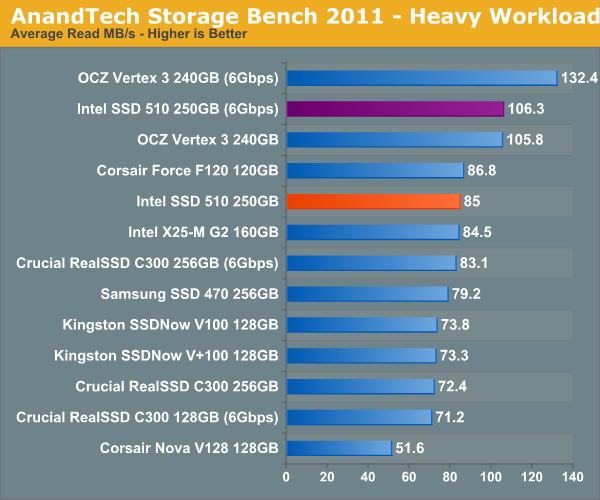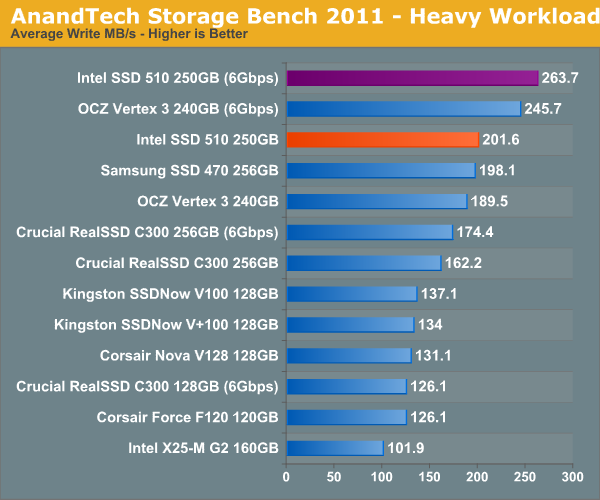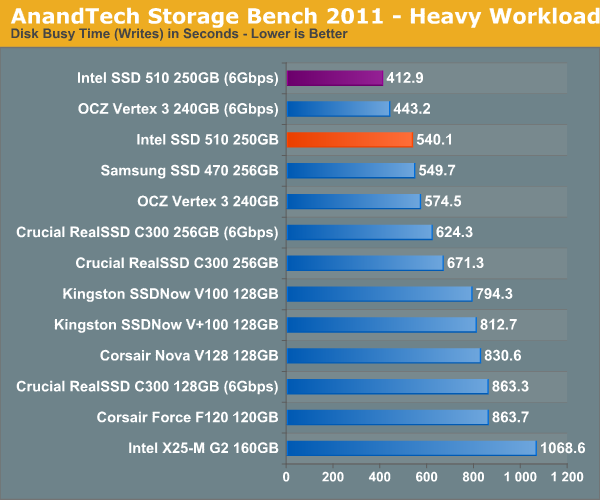The Intel SSD 510 Review
by Anand Lal Shimpi on March 2, 2011 1:23 AM EST- Posted in
- IT Computing
- Storage
- SSDs
- Intel
- Intel SSD 510
AnandTech Storage Bench 2011: Much Heavier
I didn't expect to have to debut this so soon, but I've been working on updated benchmarks for 2011. Last year we introduced our AnandTech Storage Bench, a suite of benchmarks that took traces of real OS/application usage and played them back in a repeatable manner. I assembled the traces myself out of frustration with the majority of what we have today in terms of SSD benchmarks.
Although the AnandTech Storage Bench tests did a good job of characterizing SSD performance, they weren't stressful enough. All of the tests performed less than 10GB of reads/writes and typically involved only 4GB of writes specifically. That's not even enough exceed the spare area on most SSDs. Most canned SSD benchmarks don't even come close to writing a single gigabyte of data, but that doesn't mean that simply writing 4GB is acceptable.
Originally I kept the benchmarks short enough that they wouldn't be a burden to run (~30 minutes) but long enough that they were representative of what a power user might do with their system.
Not too long ago I tweeted that I had created what I referred to as the Mother of All SSD Benchmarks (MOASB). Rather than only writing 4GB of data to the drive, this benchmark writes 106.32GB. It's the load you'd put on a drive after nearly two weeks of constant usage. And it takes a *long* time to run.
I'll be sharing the full details of the benchmark in some upcoming SSD articles but here are some details:
1) The MOASB, officially called AnandTech Storage Bench 2011 - Heavy Workload, mainly focuses on the times when your I/O activity is the highest. There is a lot of downloading and application installing that happens during the course of this test. My thinking was that it's during application installs, file copies, downloading and multitasking with all of this that you can really notice performance differences between drives.
2) I tried to cover as many bases as possible with the software I incorporated into this test. There's a lot of photo editing in Photoshop, HTML editing in Dreamweaver, web browsing, game playing/level loading (Starcraft II & WoW are both a part of the test) as well as general use stuff (application installing, virus scanning). I included a large amount of email downloading, document creation and editing as well. To top it all off I even use Visual Studio 2008 to build Chromium during the test.
Many of you have asked for a better way to really characterize performance. Simply looking at IOPS doesn't really say much. As a result I'm going to be presenting Storage Bench 2011 data in a slightly different way. We'll have performance represented as Average MB/s, with higher numbers being better. At the same time I'll be reporting how long the SSD was busy while running this test. These disk busy graphs will show you exactly how much time was shaved off by using a faster drive vs. a slower one during the course of this test. Finally, I will also break out performance into reads, writes and combined. The reason I do this is to help balance out the fact that this test is unusually write intensive, which can often hide the benefits of a drive with good read performance.
There's also a new light workload for 2011. This is a far more reasonable, typical every day use case benchmark. Lots of web browsing, photo editing (but with a greater focus on photo consumption), video playback as well as some application installs and gaming. This test isn't nearly as write intensive as the MOASB but it's still multiple times more write intensive than what we were running last year.
As always I don't believe that these two benchmarks alone are enough to characterize the performance of a drive, but hopefully along with the rest of our tests they will help provide a better idea.
The testbed for Storage Bench 2011 has changed as well. We're now using a Sandy Bridge platform with full 6Gbps support for these tests. All of the older tests are still run on our X58 platform.
AnandTech Storage Bench 2011 - Heavy Workload
We'll start out by looking at average data rate throughout our new heavy workload test:

There's simply no dethroning the Vertex 3, but Intel's SSD 510 does come dangerously close. Over a 6Gbps interface the 510 delivers 93% of the performance of the Vertex 3. Over a 3Gbps interface the gap narrows to a meager 5.2%.
The breakdown of reads vs. writes tells us more of what's going on:

The Vertex 3 is nearly 25% faster than the 510 if we just isolate the reads conducted by our benchmark. Remember the poor random read performance? I suspect that's at play here. The Intel SSD 510 on a 6Gbps interface is about the speed of the Vertex 3 on a 3Gbps port.

Ah ha! This is where the picture shifts. Our heavy workload does have a significant amount of incompressible writes which significantly reduce the performance of the Vertex 3. The V3 loses enough ground that the 510 is 7% faster in writes during our benchmark.
The next three charts just represent the same data, but in a different manner. Instead of looking at average data rate, we're looking at how long the disk was busy for during this entire test. Note that disk busy time excludes any and all idles, this is just how long the SSD was busy doing something:













128 Comments
View All Comments
TrackSmart - Wednesday, March 2, 2011 - link
It would be silly to return the Vertex 2 (my opinion). Just check out the PCMark Vantage scores in this article. There's little real world difference between all of the high end drives. Without the benchmarks, there's no way to tell the drives apart.But if it's going to eat you up inside, knowing you were just a 2-3 months away from having the latest model, go ahead. I'll be keeping be enjoying my OCZ Agility 2 in the mean time.
JohnBooty - Wednesday, March 2, 2011 - link
"I'm wondering if I should return the [Vertex 2] and just wait for the Vertex 3"I've got a mix of Vertex 1's, Intel G1s, Intel G2, and Vertex 2's in a variety of machines at home and at work.
For workstation usage as a software dev, there's not a heck of a lot of subjective (ie, "it feels faster") difference between them. At this level of disk performance, your machine just isn't waiting on the hard drive very often.
Obviously you may have specific needs. I used to work for a client who had a 8GB database that I was constantly backing up and restoring many times a day in the course of development work. Now there was a situation where raw read/write speeds were king and the Vertex 3 probably would have performed close to 2x faster. For me that kind of usage is the exception and not the rule though.
sean.crees - Wednesday, March 2, 2011 - link
I didn't see any discussion on internal garbage collection (ie: NOT trim).Does it have any?
In my mind, this will be the key deciding feature between Intel and Vertex 3. Whichever has the better garbage collection without TRIM. Remember, TRIM still doesn't work in a RAID array or in OSX.
MrCromulent - Wednesday, March 2, 2011 - link
+1. I'm really eager for an IGC comparison of the Intel 510, the Vertex 3 and if possible, also of a current firmware version of the Crucial C300 (since the drive still competes very well).In Anand's initial test, the C300 suffered from very poor IGC, but Marvell supposedly alleviated this problem in their new firmware releases. Unfortunately, no IGC tests have been conducted with the 0006 firmware yet.
halcyon - Wednesday, March 2, 2011 - link
Hate to do this, but+1.
It's not what's the latest, but what's offers the best bang for buck after upgrades.
Such a review would be immensely helpful.
Although based on the Intel 510 TRIM-test random write results, it may have to wait for the first Intel FW upgrade as the numbers with the shipping FW are truly appalling.
Syan48306 - Saturday, March 5, 2011 - link
I'm dying to know how it will hold up in my macbook pro. I finally caved and bought one of these 510 SSD's and although it's after the fact, I still want to know how long it'll still be "good" in my system.tim851 - Wednesday, March 2, 2011 - link
If the original X25-M "conroe'd" the market, it seems G3 "atomed" it. In the way that Intel, in their crusade to maximize profits and segmentize the market, designed quite a bit to conservatively.I'm all for it though, because I believe that currently, the last thing SSDs are lacking is speed, so the last thing they really need is more of it. I believe at this point just about everybody would want one, if it weren't for the prohibitively high prices. So if Intel can half the per-GB-price of the G3, I'll buy one for sure!
anactoraaron - Wednesday, March 2, 2011 - link
+1I thought the exact same thing about the 1st gen drive compared to this one. What makes SSD's "feel" so much faster is the random read/write performance. When the 40GB X25-V is so close to matching random read/write the 510 will just "feel" slow, especially once you have everything installed on it. I mean, really, who cares about sequential performance once you have everything on the drive that you planned putting on it?
Anand, please put the current WD velociraptor numbers into this graph. It will demonstrate what I mean.
Glad I didn't wait and got my 60GB Vertex 2...
anactoraaron - Wednesday, March 2, 2011 - link
oh yeah if I just looked I would see the velociraptor numbers... lol its late and I should be asleep... maybe I am? Did Intel just atom their next SSD?Golgatha - Wednesday, March 2, 2011 - link
I think this is a fair criticism. I also only look at the random R/W performance of these new SSDs. I can pull 215 MB/s R/W from my 300GB Velociraptors in RAID0, and use these drives to install all my games on since game loading performance is largely determined by sequential reading of data from the disks (lots of big sequential files), and because I need around 400GB of space currently for all my game installs .Sequential reads for most SSDs are lower than the 215 MB/s reads I enjoy from my Velociraptors in RAID0. I have a Crucial C300 256MB in this same desktop and I also use an 80GB Intel G2 in my laptop; both of these drives are slower than my Velociraptors in RAID0 in terms of sequential read performance. Also, there is obviously a space concern, in that there isn't enough space on either of these drives to install my games to them.
Now for the host OS and all the random programs I run in parallel, a SSD gives you huge gains and the system just feels snappier. This is largely due to random R/W performance. Basically you'd be hard pressed to tell the difference between sequentially reading 10MB of data or less at 215MB/s (Velociraptors in RAID0) vs 320MB/s (my Crucial C300 256MB average speed on a PCIe4x, SATA3, ASUS add-in card), hence the reason that sequential performance of SSDs doesn't matter much to me anymore.
Now if I could get a 512GB or bigger SSD with greater than 215MB/s sequential read performance for less than $1/GB, I might bite on that. So far this product has not come to market, so I'll stick with my Velociraptors until it does.